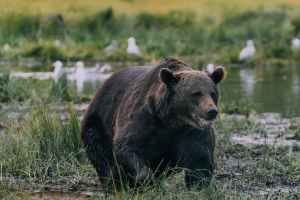
Red Panda Conservation

On our vast planet, many animals are on the brink of extinction due to various reasons, including the charming red panda.
The red panda is a small-sized, brightly colored mammal that typically inhabits bamboo and forested areas in the high mountains of Asia.
However, for various reasons, the red panda is facing the risk of extinction.
Species Description and Classification
The red panda is a carnivorous mammal classified into Ailuridae. There are currently only two extant species in this family: the red panda and the giant panda (which belongs to the bear family).
Despite its name, the red panda is not closely related to the giant panda; their common ancestor existed around 40 million years ago, belonging to different evolutionary branches.
Related
 Humans didn’t evolve wings, but our brains took flight, leading to incredible innovations instead!
Humans didn’t evolve wings, but our brains took flight, leading to incredible innovations instead!
 Bust rabbit myths for happier, healthier bunny companionship!
Bust rabbit myths for happier, healthier bunny companionship!
 Bear in sight? Stay cool, retreat slow—safety's on your side!
Bear in sight? Stay cool, retreat slow—safety's on your side!
 Medium-sized animals achieve top speed due to balanced muscle constraints.
Medium-sized animals achieve top speed due to balanced muscle constraints.
 Crimson Sunbird is nature's vibrant ambassador, weaving beauty and resilience.
Crimson Sunbird is nature's vibrant ambassador, weaving beauty and resilience.
 Cats, beloved pets, vary in breed.
Cats, beloved pets, vary in breed.
Habitat and Distribution
Red pandas are mainly found in the Himalayan mountain range and surrounding regions in Asia, including Nepal, India, Bhutan, and Myanmar. They inhabit high-altitude forests and bamboo thickets ranging from 1500 to 4800 meters above sea level, preferring areas with dense vegetation, rocks, and bamboo.
Physical Characteristics and Behavior
Renowned for its vibrant red and white facial features, the red panda is much smaller than the giant panda, with adults typically measuring between 50 to 65 centimeters in body length and an additional 30 to 50 centimeters in tail length.
Their long, bushy tails are used for balance in trees and warmth during colder periods. Red pandas are nocturnal animals, spending most of their time foraging for food, primarily bamboo, supplemented occasionally with insects, small birds, and other small mammals.
Threats and Conservation Status
Despite not being heavily hunted historically, red pandas face severe threats today. Habitat loss is a major factor due to deforestation, land development, and climate change, leading to a rapid decline in suitable habitats.
Additionally, illegal hunting and fur trade pose serious threats to their populations, despite legal protections in multiple countries; enforcement issues still result in illegal capture and trafficking.
To protect the red panda, governments and conservation organizations in various countries have implemented multiple measures. These include establishing protected areas, promoting sustainable land use practices, enhancing monitoring and enforcement efforts, and raising public awareness about these animals.
For example, Nepal's Bokse Conservation Area and India's Himalayan National Parks are crucial protected areas specifically dedicated to conserving red pandas and their habitats.
Scientific Research and Conservation Hope
Scientists are actively studying the ecological behaviors, genetic diversity, and optimal conservation strategies for red pandas.
Modern technologies such as remote sensing and genetic analysis enable researchers to accurately locate habitats, monitor population numbers, and assess their range, crucial for developing conservation policies and action plans.
Despite facing immense challenges, global conservation efforts and increased public awareness offer hope for these fascinating and unique animals, the Himalayan red pandas. Looking ahead, through international cooperation and sustained efforts, we can ensure the continued survival of Himalayan red pandas on Earth and leave behind a diverse and beautiful natural heritage for future generations.

Conclusion
The red panda, as a part of Earth's unique biodiversity, represents not just a species but also a symbol of harmonious coexistence between humans and nature.
By protecting these adorable and endangered animals, we are not only saving a species but also maintaining the stability and integrity of entire ecosystems. Let's hope we can work together to strive for the conservation and survival of the red panda's future!